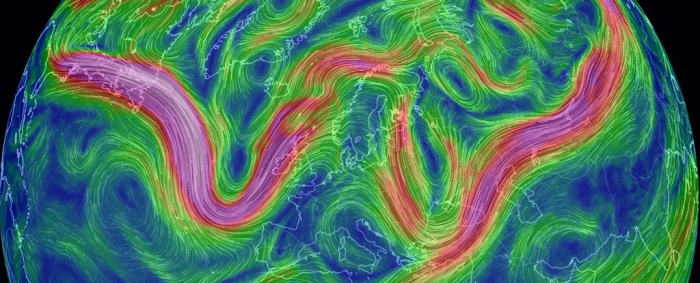The plane made an emergency landing at John F. Kennedy International Airport, where 28 passengers and two crew members were treated for injuries, according to news reports.
That flight was cruising over Maine when it encountered severe turbulence, known as clear-air turbulence because it occurs in clear skies without an obvious visual cue for the pilots.
Such incidents may become more common in the skies above the North Atlantic due to changes in wind shear as a result of human-caused climate change, according to a new study published Wednesday.
One of the major causes of clear air turbulence is wind shear, which occurs when winds vary in speed or direction with height.
The new study, published in the journal Nature, is the first to detect a statistically significant increase in vertical wind shear at jet-stream altitudes across the North Atlantic. Changes here can have a significant influence on aviation, since nearly 3,000 flights cross the pond on an average day.
The study focuses on the North Atlantic for two main reasons: It's the world's busiest overseas flight corridor, and flights crossing the ocean in this region are typically exposed to the polar jet stream for the duration of their flight, particularly during the winter.
The turbulence research focuses on the main driver of mid-latitude jet streams: The temperature difference between the equator and the North Pole, which powers what is known as the thermal wind.
In general, the greater the temperature contrast between the equator and the pole, the stronger the jet stream will blow from west to east across the North Atlantic, steering and energizing storm systems along with it.
The new study, by meteorologists at the University of Reading, finds that at higher altitudes, including the lower stratosphere over the pole, temperatures have been declining in response to rapid Arctic climate change.
Meanwhile, the upper troposphere above the equator features increasing average temperatures. This means the temperature contrast is increasing at these altitudes.
Yet lower down in the troposphere, the opposite is taking place: Temperature changes are weakening the temperature gradient and are expected to slacken the jet stream. This weakening of the jet stream has received a lot of media attention in recent years.
When these two trends are added up, so far they're balancing out, which is why most studies on the topic only find small shifts in jet stream speeds and location in recent years.
But the wind shear associated with the jet stream is clearly increasing, the study finds.
"If the jet stream slows down in the lower atmosphere, but remains unchanged in the upper atmosphere, then the shear in the upper atmosphere must have increased," study co-author Paul D. Williams said via email.
"So although it might sound counter-intuitive, there is no mathematical contradiction between having (in the upper atmosphere) increased wind shear without increased wind speed."
Since airliners cruise in the upper troposphere to lower stratosphere, the study shows that they may be buffeted by greater wind shear in the transition zone between the higher winds there and weaker wind speeds just below.
"The shear itself is driven by the temperature difference at any given level of atmosphere that you're at," said lead author Simon H. Lee, in an interview.
The study is a step forward because it finds a detectable change in wind shear associated with the North Atlantic upper-level jet stream during the 39-year satellite era, rather than simply examining wind speeds, as past studies had done. In fact, this study bolsters other recent work that has found a lack of a clear trend in the speed of the polar jet stream at about 34,000 feet since 1979.
During the same period, there has been a 15 percent increase in vertical wind shear at that altitude, the study finds.
The increase in shear was found in three different data sets of conditions since 1979.
"Climate models already show two to three times more severe turbulence come the middle of the 21st century," Lee says. "Now what we've done is look at the observations and we find that actually one of the key [turbulence] drivers has increased."
"To find something clear cut like 15 percent that's why the headline message is that climate change is having a larger impact on the jet than previously thought," Lee says.
The focus on shear allows the authors to draw conclusions about turbulence trends, concluding that future trans-Atlantic flights may encounter more clear air turbulence than they are now. They note that climate projections show that the North Atlantic will see a greater increase in clear-air turbulence at cruising altitude than anywhere else in the world.
Williams says the relationship between climate change and increased clear-air turbulence is "well-established and entirely consistent with our understanding of the physics of turbulence generation."
Judah Cohen, a meteorologist with AER, a Verisk company, said the study appears to be "consistent with other more recent publications on the topic and consider both impacts of Arctic amplification and upper troposphere tropical warming."
Cohen, who was not involved in the new research, said its findings appear to run counter to other recent research showing that the thermal wind is declining due to rapid Arctic warming, particularly during the summer months.
As for a message to nervous fliers who might not be looking forward to more turbulent skies, such as veterans of that ill-fated Turkish Airlines flight, Williams says that despite his understanding of what causes turbulence, Williams says he's right there with them.
"Turbulence is what I study every day, but that doesn't make me immune to the fear of flying through it. It seems to grab a very primitive part of your brain and override all your rational thoughts. So although I know that I'm almost certainly safe, I still find it unpleasant," he says.
Lee reassuringly reminds people that turbulence is not a typical cause of airplane crashes: "The chances of your plane going down due to turbulence are really nil."
The Washington Post
More about: #ClimateChange
















































